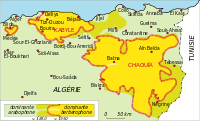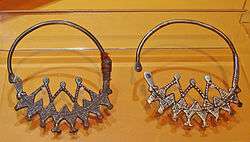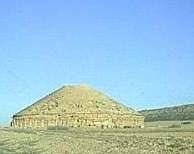Chaoui people
| Total population | |
|---|---|
| (More than 2,000,000[1]) | |
| Languages | |
| Shawiya | |
| Religion | |
| Sunni Islam[2] | |
| Related ethnic groups | |
Berbers |
.jpg)
The Chaoui people or Shawia (Algerian Arabic: شاويه, Shawiya: Išawiyen) are a Berber population inhabiting the Aurès, Nememcha and Belezma regions located in and surrounded by the Aurès Mountains. They also live in the Tébessa area and other parts of eastern Algeria coextensive with ancient Numidia, as well as a few adjacent towns in Tunisia. They call themselves Išawiyen/Icawiyen (pronounced [iʃawijən]) and speak the Shawiya language.
History
Historically, the Aurès Mountains served as a refuge for Berber peoples, forming a base of resistance against the Roman Empire, the Vandals, the Byzantine Empire and Arabs. Aurès was also a district of Algeria that existed during and after the Algerian War from 1954 to 1962. It was in this region that Berber freedom fighters started the war.
The patriarch of Berbers is believed to be Madghacen, common ancestor of the Zenata and of the Botri as well. Ibn Khaldun identified the Zenata as Berbers. Modern historians rank this Berber region within the group of Numidians and Gaetuli or the much more ancient such as Meshwesh, Maesulians and Mazaxes, from whom formed the Zenata, the main inhabitants of the Aurès in the Middle Ages. Chaoui clans known by Ibn Khaldoun were the Ifren, Maghrawa, Djerawa, Abdalwadides, Howara and Awarba.
Etymologically, the term Chaoui/Shawi derives from the word Ic "horn", allegedly a reference to the national god of the Numidians, Amun, who is depicted as a human head with the horns of a ram.
After the independence of Algeria, the Chaouis remained localized mainly in the Auresian region. They represent the first ethnic group in Algeria and second Berber-speaking group in terms of number of speakers, the first being the Kabyle.
Language
The Chaoui traditionally speak the Shawiya language (Berber: Tachawit). It belongs to the Berber branch of the Afro-Asiatic family, and is a variety of the Zenati languages.
Shawiya is a closely related cluster of dialects spoken in the Aurès region (Berber: Awras) of eastern Algeria and surrounding areas including Batna, Khenchela, south Sétif, Oum El Bouaghi, Souk Ahras, Tébessa, and the north part of Biskra.
Recently the Shawiya language, together with the Kabyle language, has begun to achieve some cultural prominence due to the Berber cultural and political movements in Algeria.
Culture and art
 Bendir with snares |
 Chaoui jewelry, Museum of Man, Paris, during an exhibition Germaine Tillion. |
 Chaoui bread. |
Chaoui music is a specific style of Berber music. The Shawia dance is called Rahaba; men and women dancing at weddings. There are many 20th century singers, such as Aïssa Djermouni, Ali Khencheli, Massinissa, Ishem Boumaraf, Djamel Sabri, Houria Aïchi, etc.
Chaoui painters and sculptors (of whom there are many) include Cherif Merzouki, Abdelkhader Houamel, Hassane Amraoui, Adel Abdessemed, and Mohamed Demagh.
The Fantasia (culture) is a traditional exhibition of horsemanship in the Aurès performed during cultural festivals.
References
- ↑ "Centre de Recherche Berbère - Chaouia". www.centrederechercheberbere.fr.
- ↑ "Shawiya of Algeria". joshuaproject.net. Retrieved September 11, 2012.
Bibliography
|
|
Film
- Hakkar A., La maison jaune, 2008.
External links
 Media related to Chaoui people at Wikimedia Commons
Media related to Chaoui people at Wikimedia Commons- Chawi people in 1952 on YouTube
- Pictures of Chaouis
- Videos in Chaoui
- chawinet.com (in French)
- http://www.truveo.com/khouya-ya-chaoui/id/2928217872
- Among the hill-folk of Algeria: journeys among the Shawía of the Aurès Mountains (1921) by Melville William Hilton-Simpson
